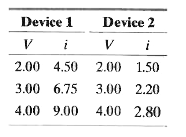The following tables gives the current i (in amperes) through two devices for several values of potential difference V (in volts). From these data, determine which device does not obey Ohm's law. 
The correct Answer is:device 2
Step by step video, text & image solution for The following tables gives the current i (in amperes) through two devices for several values of potential difference V (in volts). From these data, determine which device does not obey Ohm's law. by Physics experts to help you in doubts & scoring excellent marks in Class 12 exams.
Updated on:21/07/2023Topper's Solved these Questions
- CURRENT AND RESISTANCEBook:RESNICK AND HALLIDAYChapter:CURRENT AND RESISTANCEExercise:Problems
Explore 36 Videos
- CURRENT AND RESISTANCEBook:RESNICK AND HALLIDAYChapter:CURRENT AND RESISTANCEExercise:Practice Questions (Single Corret Choice Type)
Explore 39 Videos
- CURRENT AND RESISTANCEBook:RESNICK AND HALLIDAYChapter:CURRENT AND RESISTANCEExercise:Practice Questions (Integer Type)
Explore 3 Videos
- CIRCULAR MOTIONBook:RESNICK AND HALLIDAYChapter:CIRCULAR MOTIONExercise:CHECK POINTS
Explore 6 Videos
- ELASTICITYBook:RESNICK AND HALLIDAYChapter:ELASTICITYExercise:PRACTICE QUESTIONS (Integer Type)
Explore 3 Videos
Similar Questions
In an experiment, the current flowing through a resistor and the potential difference across it are measured. The values are given below. Show that these values confirm Ohm's law, and find the resistance of the resistor.

View SolutionIn an experiment, the current flowing through a resistor and the potential difference across it are measured. The values are given below. Show that these values confirm Ohm's law, and find the resistance of the resistor.
i(ampere)1.01.52.02.53.0V(volt)4.06.08.010.012
View Solution
Knowledge Check
A current of 2.0 ampere passes through a cell of e.m.f. 1.5 volts having internal resistance of 0.15 ohm. The potential difference measured, in volts, across both the ends of the cell will be
A1.35B1.50C1.00D1.20A battery of emf E has an internal resistance r. A variable resistacne R is connected to the terminals of the battery. A current i is drawn from the battery. V is the terminal potential difference. If R alone is gradually reduced to zero, which of the following best describes i and V?
Ai approaches zero, V approaches EBi approaches Er, V approaches zeroCi approaches Er, V approaches EDi approaches infinity, Er, V approaches EImagine a conductor through which a current I is flowing and let V be the potential difference between the ends of the conductor. Then, Ohm’s law states that
AV∞lBV = RICV = 2 RIDBoth (1) and (2)
A part of a complete circuit is shown in the figure . At some instant the value of current I is 1 A and it is decreasing at a rate of 102As−1 . The value of the potential difference VP−VQ, (in volts) at that instant , is ____________.

View SolutionWrite the relation between electric power (P) in watt of a device with potential difference (V volt) across it and current (l ampere) flowing through it.
View SolutionMention the condition under which charges can move in a conductor. Name the device which is used to maintain this condition in an electric circuit.
(b) A current of 2A passes through a circuit for 1 minute. IF potential difference between the terminals of the circuit is 3V, what is the work done is transferring the charge?
View SolutionLight is incident on the cathode of a photocell and the stopping voltages are measured from light of two difference wavelengths. From the data given below, determine the work function of the metal of the cathode in eV and the value of the universal constant hc/e.
Wavelength (Å) Stopping voltage (volt)
4000 1.3
4500 0.9
View SolutionIf V is the potential difference between the ends of conductor and l is the current through it, then ohm's law states that
View Solution